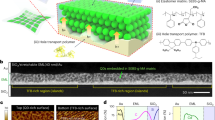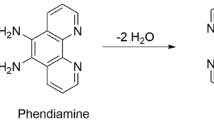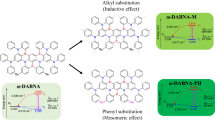Abstract
The visualization of accurate colour information using quantum dots has been explored for decades, and commercial products employing environmentally friendly materials are currently available as backlights1. However, next-generation electroluminescent displays based on quantum dots require the development of an efficient and stable cadmium-free blue-light-emitting device, which has remained a challenge because of the inferior photophysical properties of blue-light-emitting materials2,3. Here we present the synthesis of ZnSe-based blue-light-emitting quantum dots with a quantum yield of unity. We found that hydrofluoric acid and zinc chloride additives are effective at enhancing luminescence efficiency by eliminating stacking faults in the ZnSe crystalline structure. In addition, chloride passivation through liquid or solid ligand exchange leads to slow radiative recombination, high thermal stability and efficient charge-transport properties. We constructed double quantum dot emitting layers with gradient chloride content in a light-emitting diode to facilitate hole transport, and the resulting device showed an efficiency at the theoretical limit, high brightness and long operational lifetime. We anticipate that our efficient and stable blue quantum dot light-emitting devices can facilitate the development of electroluminescent full-colour displays using quantum dots.
This is a preview of subscription content, access via your institution
Access options
Access Nature and 54 other Nature Portfolio journals
Get Nature+, our best-value online-access subscription
$29.99 / 30 days
cancel any time
Subscribe to this journal
Receive 51 print issues and online access
$199.00 per year
only $3.90 per issue
Buy this article
- Purchase on Springer Link
- Instant access to full article PDF
Prices may be subject to local taxes which are calculated during checkout




Similar content being viewed by others
Data availability
All data generated or analysed during this study are included in the paper and its Supplementary Information files.
References
Jang, E., Kim, Y., Won, Y.-H., Jang, H. & Choi, S.-M. Environmentally friendly InP-based quantum dots for efficient wide color gamut displays. ACS Energy Lett. 5, 1316–1327 (2020).
Shirasaki, Y., Supran, G. J., Bawendi, M. G. & Bulović, V. Emergence of colloidal quantum-dot light-emitting technologies. Nat. Photon. 7, 13–23 (2013).
Dai, X., Deng, Y., Peng, X. & Jin, Y. Quantum-dot light-emitting diodes for large-area displays: towards the dawn of commercialization. Adv. Mater. 29, 1607022 (2017).
Colvin, V. L., Schlamp, M. C. & Alivisatos, A. P. Light-emitting diodes made from cadmium selenide nanocrystals and a semiconducting polymer. Nature 370, 354–357 (1994).
Dai, X. et al. Solution-processed, high-performance light-emitting diodes based on quantum dots. Nature 515, 96–99 (2014).
Li, X. et al. Quantum-dot light-emitting diodes for outdoor displays with high stability at high brightness. Adv. Opt. Mater. 8, 1901145 (2020).
Wang, L. et al. Blue quantum dot light-emitting diodes with high electroluminescent efficiency. ACS Appl. Mater. Interfaces 9, 38755–38760 (2017).
Pu, C. et al. Electrochemically-stable ligands bridge the photoluminescence–electroluminescence gap of quantum dots. Nat. Commun. 11, 937 (2020).
Yang, Y. et al. High-efficiency light-emitting devices based on quantum dots with tailored nanostructures. Nat. Photon. 9, 259–266 (2015).
Chen, S. et al. On the degradation mechanisms of quantum-dot light-emitting diodes. Nat. Commun. 10, 765 (2019).
Won, Y.-H. et al. Highly efficient and stable InP/ZnSe/ZnS quantum dot light-emitting diodes. Nature 575, 634–638 (2019).
Shen, W. et al. Synthesis of highly fluorescent InP/ZnS small-core/thick-shell tetrahedral-shaped quantum dots for blue light-emitting diodes. J. Mater. Chem. C 5, 8243–8249 (2017).
Zhang, H. et al. High-brightness blue InP quantum dot-based electroluminescent devices: the role of shell thickness. J. Phys. Chem. Lett. 11, 960–967 (2020).
Lesnyak, V., Dubavik, A., Plotnikov, A., Gaponik, N. & Eychmüller, A. One-step aqueous synthesis of blue-emitting glutathione-capped ZnSe1−xTex alloyed nanocrystals. Chem. Commun. 46, 886–888 (2010).
Asano, H., Tsukuda, S., Kita, M., Fujimoto, S. & Omata, T. Colloidal Zn(Te,Se)/ZnS core/shell quantum dots exhibiting narrow-band and green photoluminescence. ACS Omega 3, 6703–6709 (2018).
Jang, E.-P. et al. Synthesis of alloyed ZnSeTe quantum dots as bright, color-pure blue emitters. ACS Appl. Mater. Interfaces 11, 46062–46069 (2019).
Han, C.-Y. et al. More than 9% efficient ZnSeTe quantum dot-based blue electroluminescent devices. ACS Energy Lett. 5, 1568–1576 (2020).
Orfield, N. J., McBride, J. R., Keene, J. D., Davis, L. M. & Rosenthal, S. J. Correlation of atomic structure and photoluminescence of the same quantum dot: pinpointing surface and internal defects that inhibit photoluminescence. ACS Nano 9, 831–839 (2015).
Zhang, L., Lin, Z., Luo, J.-W. & Franceschetti, A. The birth of a type-II nanostructure: carrier localization and optical properties of isoelectronically doped CdSe:Te nanocrystals. ACS Nano 6, 8325–8334 (2012).
Avidan, A. & Oron, D. Large blue shift of the biexciton state in tellurium doped cdse colloidal quantum dots. Nano Lett. 8, 2384–2387 (2008).
Brittman, S. et al. Effects of a lead chloride shell on lead sulfide quantum dots. J. Phys. Chem. Lett. 10, 1914–1918 (2019).
Zherebetskyy, D. et al. Hydroxylation of the surface of PbS nanocrystals passivated with oleic acid. Science 344, 1380–1384 (2014).
Ip, A. H. et al. Hybrid passivated colloidal quantum dot solids. Nat. Nanotechnol. 7, 577–582 (2012).
Bae, W. K. et al. Highly effective surface passivation of pbse quantum dots through reaction with molecular chlorine. J. Am. Chem. Soc. 134, 20160–20168 (2012).
Tang, J. et al. Colloidal-quantum-dot photovoltaics using atomic-ligand passivation. Nat. Mater. 10, 765–771 (2011).
Zhang, H., Jang, J., Liu, W. & Talapin, D. V. Colloidal nanocrystals with inorganic halide, pseudohalide, and halometallate ligands. ACS Nano 8, 7359–7369 (2014).
Shen, H. et al. High-efficiency, low turn-on voltage blue-violet quantum-dot-based light-emitting diodes. Nano Lett. 15, 1211–1216 (2015).
Li, X. et al. Bright colloidal quantum dot light-emitting diodes enabled by efficient chlorination. Nat. Photon. 12, 159–164 (2018).
Takahashi, J. & Naito, H. Visualization of the carrier transport dynamics in layered organic light emitting diodes by modulus spectroscopy. Org. Electron. 61, 10–17 (2018).
Okachi, T., Nagase, T., Kobayashi, T. & Naito, H. Equivalent circuits of polymer light-emitting diodes with hole-injection layer studied by impedance spectroscopy. Thin Solid Films 517, 1327–1330 (2008).
Qian, L., Zheng, Y., Xue, J. & Holloway, P. H. Stable and efficient quantum-dot light-emitting diodes based on solution-processed multilayer structures. Nat. Photon. 5, 543–548 (2011).
Cohen, M. L. Pseudopotentials and total energy calculations. Phys. Scr. T1, 5–10 (1982).
Perdew, J. P., Burke, K. & Ernzerhof, M. Generalized gradient approximation made simple. Phys. Rev. Lett. 77, 3865–3868 (1996).
Kresse, G. & Hafner, J. Ab initio molecular-dynamics simulation of the liquid-metal–amorphous-semiconductor transition in germanium. Phys. Rev. B 49, 14251–14269 (1994).
Heyd, J., Scuseria, G. E. & Ernzerhof, M. Hybrid functionals based on a screened Coulomb potential. J. Chem. Phys. 118, 8207–8215 (2003).
Kim, S. et al. Efficient blue-light-emitting Cd-free colloidal quantum well and its application in electroluminescent devices. Chem. Mater. 32, 5200–5207 (2020).
Asano, H. & Omata, T. Design of cadmium-free colloidal II–VI semiconductor quantum dots exhibiting RGB emission. AIP Adv. 7, 045309 (2017).
Faschinger, W., Ferreira, S. & Sitter, H. Doping of zinc-selenide-telluride. Appl. Phys. Lett. 64, 2682–2684 (1994).
Li, Y.-H. et al. Revised ab initio natural band offsets of all group IV, II–VI, and III–V semiconductors. Appl. Phys. Lett. 94, 212109 (2009).
Kwak, J. et al. Bright and efficient full-color colloidal quantum dot light-emitting diodes using an inverted device structure. Nano Lett. 12, 2362–2366 (2012).
Lee, K.-H. et al. Highly efficient, color-pure, color-stable blue quantum dot light-emitting devices. ACS Nano 7, 7295–7302 (2013).
Shen, H. et al. Efficient and long-lifetime full-color light-emitting diodes using high luminescence quantum yield thick-shell quantum dots. Nanoscale 9, 13583–13591 (2017).
Lin, Q. et al. Nonblinking quantum-dot-based blue light-emitting diodes with high efficiency and a balanced charge-injection process. ACS Photonics 5, 939–946 (2018).
Wang, O. et al. High-efficiency, deep blue ZnCdS/CdxZn1−xS/ZnS quantum-dot-light-emitting devices with an EQE exceeding 18%. Nanoscale 10, 5650–5657 (2018).
Shen, H. et al. Visible quantum dot light-emitting diodes with simultaneous high brightness and efficiency. Nat. Photon. 13, 192–197 (2019).
Shen, H. et al. Phosphine-free synthesis of high quality ZnSe, ZnSe/ZnS, and Cu-, Mn-doped ZnSe nanocrystals. Dalt. Trans. 47, 10534–10540 (2009).
Ji, W. et al. High color purity ZnSe/ZnS core/shell quantum dot based blue light emitting diodes with an inverted device structure. Appl. Phys. Lett. 103, 053106 (2013).
Ippen, C. et al. ZnSe/ZnS quantum dots as emitting material in blue QD-LEDs with narrow emission peak and wavelength tunability. Org. Electron. 15, 126–131 (2014).
Lin, Q. et al. Cadmium-free quantum dots based violet light-emitting diodes: high-efficiency and brightness via optimization of organic hole transport layers. Org. Electron. 25, 178–183 (2015).
Wang, A. et al. Bright, efficient, and color-stable violet ZnSe-based quantum dot light-emitting diodes. Nanoscale 7, 2951–2959 (2015).
Ji, B., Koley, S., Slobodkin, I., Remennik, S. & Banin, U. ZnSe/ZnS core/shell quantum dots with superior optical properties through thermodynamic shell growth. Nano Lett. 20, 2387–2395 (2020).
Acknowledgements
We thank H. Kim in RIAM of SNU for the TEM analysis and H. Jung for the photospectroscopic measurements.
Author information
Authors and Affiliations
Contributions
The synthesis and structural analysis of QDs were performed by T.K., H.J. and S.K. The chloride exchange and analysis were performed by T.K. and K.-H.K. The QD-LEDs were fabricated and characterized by K.-H.K., H.-K.S., H.L., D.-Y.C. and T.K. The modelling was performed by S.-M.C. This research was designed and coordinated by E.J. The manuscript was written by T.K. and E.J. in consultation with all authors.
Corresponding author
Ethics declarations
Competing interests
The authors declare no competing interests.
Additional information
Peer review information Nature thanks the anonymous reviewers for their contribution to the peer review of this work. Peer reviewer reports are available.
Publisher’s note Springer Nature remains neutral with regard to jurisdictional claims in published maps and institutional affiliations.
Extended data figures and tables
Extended Data Fig. 1 Characterization of core, C/S and C/S/S QDs.
a, Particle-size distributions of core, C/S and C/S/S QDs, determined from the respective STEM images in Fig. 1. b, Elemental mapping of C/S/S QDs obtained by STEM-EDX. c, XRD patterns of core, C/S and C/S/S QDs, together with the reference zinc blende structure of ZnSe (X-ray diffraction pattern PDF 00-037-1463) and ZnS (PDF 00-005-0566). d–f, Contour maps of the calculated emission wavelength of ZnTeSe/ZnSe/ZnS (with a fixed ZnS thickness of 1.2 nm) as a function of ZnTexSe1−x core size and ZnSe shell thickness for x = 0 (d), x = 0.033 (e) and x = 0.067 (f). The star in f corresponds to the C/S/S QD shown in Fig. 1.
Extended Data Fig. 2 Effect of HF and ZnCl2 additives on structure and optical properties.
a, SAED and XRD patterns of ZnTeSe/ZnSe/ZnS C/S/S QDs prepared without any additives (left), with HF only (middle) and with ZnCl2 only (right). The red, yellow and green dashed lines indicate stacking faults assigned to 26°, 29° and 50°, respectively. b, STEM images (white scale bar, 20 nm). Inset, high-resolution TEM images (yellow scale bar, 2 nm), c, d, Absorption and photoluminescence spectra (c) and TR-PL profiles (d) of ZnTeSe/ZnSe/ZnS C/S/S QDs prepared without any additive (‘None’), with HF only and with ZnCl2 only. Average decay lifetimes fitted with a multi-component exponential function are indicated. e, f, Absorption and photoluminescence spectra (e) and TR-PL profiles (f) of ZnTexSe1−x/ZnSe/ZnS C/S/S QDs with x = 0, 0.033, 0.067 and 0.1. g, Schematic energy level diagram of radiative and non-radiative transition pathways. CB, conductance band; VB, valence band.
Extended Data Fig. 3 Effect of chloride passivation on physical properties.
a, TR-PL spectra and average decay lifetimes of solutions of core, C/S, C/S/S and C/S/S-Cl(l) QDs (excitation at 405 nm, measured at each emission peak). b, c, Photoluminescence spectra (b) and TR-PL spectra and average decay lifetimes (c) of films of C/S/S, C/S/S-Cl(l) and C/S/S-Cl(f) QDs. d, TGA curves of C/S/S, C/S/S-Cl(l) and C/S/S-Cl(l) aggregates. The shaded area indicates the weight loss of OA ligands. e, FT-IR spectra of films prepared with C/S/S, C/S/S-Cl(l) and C/S/S-Cl(f) QDs. Inset, magnification of the spectra showing asymmetric (v1) and symmetric (v2) vibrations of the carboxylate group with aliphatic stretching (v3). The wavenumber difference between v1 and v2 is indicated (145 cm−1) to explain the binding mode of oleate corresponding to briging bidentate. f–h, Size of QDs dispersed in octane and measured with DLS: C/S/S (f), C/S/S-Cl(l) (g) and C/S/S-Cl(l) (h) aggregates. i–l, High-resolution XPS spectra of elements in C/S/S, C/S/S-Cl(l) and C/S/S-Cl (f): zinc 2p3 (i), selenium 3d (j), sulfur 2p (k) and chlorine 2p (l).
Extended Data Fig. 4 Dependence of ligand binding energy on ZnS surface.
a, Calculated binding energy of Ac and Cl with Zn atoms on a ZnS (100) surface as a function of ligand density. b, Optimized structures of Ac and Cl on ZnS (100) surfaces for each composition.
Extended Data Fig. 5 Analysis of chlorinated films and resulting devices.
a, Photoelectron spectroscopy data for C/S/S, C/S/S-Cl(l), C/S/S-Cl(f) and OA films. The corresponding ionization potentials are indicated. b, Energy-band diagrams of QD-LEDs with C/S/S-OA (left) and double EMLs (right). c–e, SEM images of QD films prepared with C/S/S (c), C/S/S-Cl(f) (d) and a double layer consisting of C/S/S-Cl(f) (bottom layer) and C/S/S-Cl(l) (top layer) (e). Insets, dot-to-dot distances between QDs for C/S/S and C/S/S-Cl(f) (the average distances are 14.1 ± 1.2 nm and 13.7 ± 1.2 nm, respectively). f, Cross-sectional TEM image used for EDX elemental analysis of the QD-LED with a double EML of C/S/S-Cl(l) over C/S/S-Cl(f). g, Elemental composition at each probed position in e.
Extended Data Fig. 6 Statistics of device performance.
a, b, Distributions of maximum EQE (a) and maximum brightness (b) obtained from 90 QD-LEDs with double EML. c, Operational lifetimes of QD-LEDs with a double EML consisting of C/S/S-Cl(l) over C/S/S-Cl(f) for different initial brightness values. d, Measured lifetime (T50) of the devices versus brightness. The T50 value at 100 cd m−2 was estimated by fitting with the empirical equation \({L}_{0}^{n}\times {T}_{50}={\rm{constant}}\), where L0 is the initial brightness and n is the acceleration factor.
Extended Data Fig. 7 Characterization of single-carrier devices.
a–f, Current density–voltage characteristics and mobilities calculated from the fitting curves using the space charge-limited current model (SCLC) for HODs with C/S/S, C/S/S-Cl(l) and C/S/S-Cl(f) QDs (a–c) and EODs with C/S/S, C/S/S-Cl(l) and C/S/S-Cl(f) QDs (d–f). g, h, Mott–Schottky analysis of HODs (g) and EODs (h) with no QDs and with C/S/S, C/S/S-Cl(l) and C/S/S-Cl(f) QDs.
Extended Data Fig. 8 Analysis of double-EML devices.
a–c, Voltage-dependent electroluminescence spectra of QD-LEDs with double EML, consisting of a C/S/S top layer with red-emitting InP/ZnSe/ZnS QDs and different bottom EMLs: C/S/S (a), C/S/S-Cl(l) (b) and C/S/S-Cl(f) (c). The insets show electroluminescence spectra at low voltages. d, Complex modulus spectra measured at various voltages before and after the T50 lifetime test for QD-LEDs with C/S/S-Cl(f). The real (horizontal axis) and imaginary (vertical axis) moduli were calculated using the equation M = iωZ, where i is the imaginary unit, ω is the frequency and Z is the complex impedance29. The grey arrow shows the direction of increasing frequency.
Supplementary information
Rights and permissions
About this article
Cite this article
Kim, T., Kim, KH., Kim, S. et al. Efficient and stable blue quantum dot light-emitting diode. Nature 586, 385–389 (2020). https://doi.org/10.1038/s41586-020-2791-x
Received:
Accepted:
Published:
Issue Date:
DOI: https://doi.org/10.1038/s41586-020-2791-x
This article is cited by
-
Dipole–dipole-interaction-assisted self-assembly of quantum dots for highly efficient light-emitting diodes
Nature Photonics (2024)
-
Stable and efficient pure blue quantum-dot LEDs enabled by inserting an anti-oxidation layer
Nature Communications (2024)
-
High efficiency warm-white light-emitting diodes based on copper–iodide clusters
Nature Photonics (2024)
-
Investigation of operation and degradation mechanisms in ZnTeSe blue quantum-dot light-emitting diodes by identifying recombination zone
Nano Research (2024)
-
Wearable and Implantable Light-Emitting Diodes and Their Biomedical Applications
Korean Journal of Chemical Engineering (2024)
Comments
By submitting a comment you agree to abide by our Terms and Community Guidelines. If you find something abusive or that does not comply with our terms or guidelines please flag it as inappropriate.



